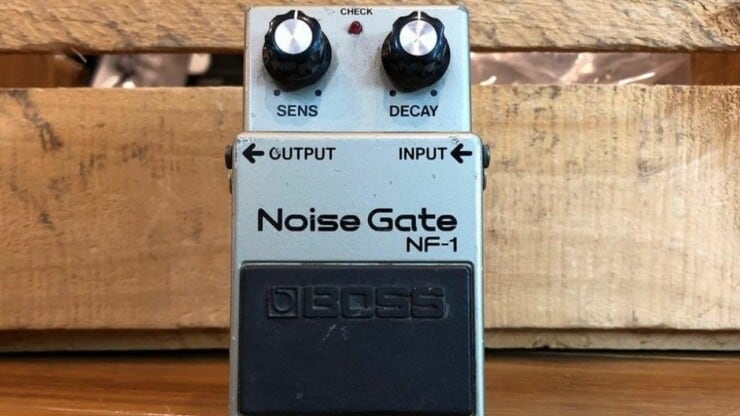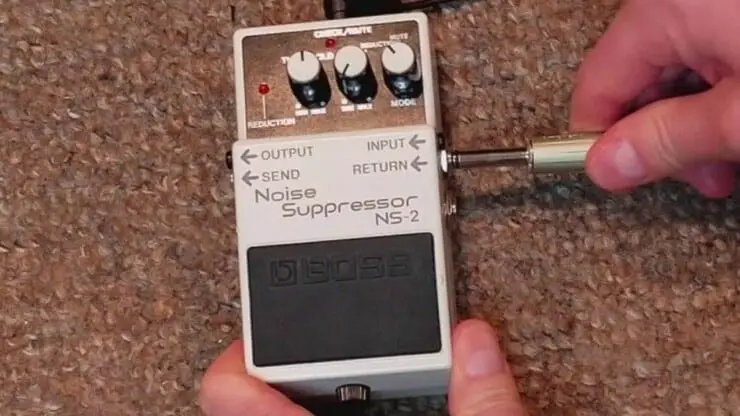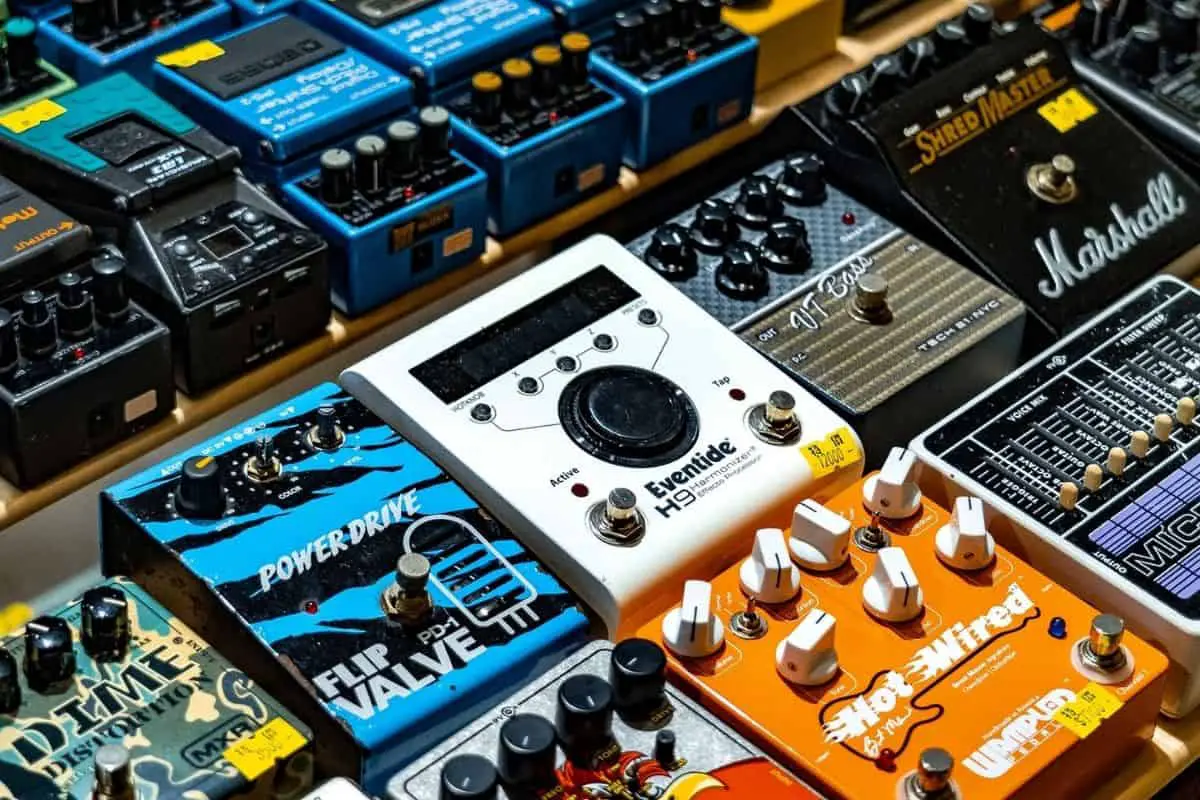Are you a beginner guitarist still learning your trade and coming to terms with concepts like what is a noise gate pedal? If yes, then you’re definitely in the right place.
A noise gate pedal does a great job creating interesting sound effects when playing the guitar. Include it in your pedalboard, and you’ll take your guitar to a whole new level.
In this article, you’ll get to know all about what is a noise gate pedal, what does a noise gate pedal do, how to use a noise gate pedal, tips to remember when using it, and more. Continue reading to get all the answers you’re looking for.
What is a noise gate pedal?
A noise gate pedal will create interesting sound effects when used correctly. Bass and guitar players generally use a pedal if they want to unblock any undesired signals in their electric setup. The reason why noise gate pedals aren’t as popular is that they’re used prominently by professionals. They’re used either in recording studios or on stage.
Noise gate pedals are traditionally devices that maintain the quality of the sound output at a high level. Meanwhile, they also help block the unwanted signals. As you’d know, your guitar is typically connected to the amp through a cable. Between the two devices, there will be a lot of different audio signals coming from different sources. For instance, single-coil pickup guitars could create some of these signals.
There are some guitarists who prefer using a single-coil pedal that can meet their requirements. These are normally called multi-effect pedals and shouldn’t be confused with noise gate pedals or effect pedals. The key thing to remember regarding noise gate pedals is the threshold level. On the front side of the noise gate pedal, there’s a large control knob allowing you to establish the noise level. This level will vary depending on the brand of the pedal, normally it is between -70dB and +10dB. Once the level of noise has gone above/below this interval, the noise gate gets triggered to block any unwanted sounds.
What does a noise gate pedal do?
A noise gate pedal will do precisely what it says in the name. The gate will open if your level is above a certain threshold and close once it falls below the threshold. This way, it’ll allow you to let in only the desired amount of signal. In most cases, your actual guitar playing will be louder than the hum of the rig. This way, you can set the threshold for sitting at the same level as the hum. All it’ll take is a bit more experimentation and no more unwanted noise.

Noise gates will be particularly popular with the high-gain crowd. Such artists can easily combine loud, distorted sounds with ample space – creating the perfect storm when rigging the noise. Some guitarists can live with this noise, while many purists think that it is old-school. Most people just want to have a solution that can easily reduce hum. But what causes the unwanted noise?
- Type of amp – Valve amps tend to get noisier with age. Solid-state amps will be more reliable and will not produce as much noise. Anything high-gain will buzz a bit more.
- Amount of gain and volume – All amps will have a noise floor (a certain quantity of buzz or hum by default). The more that you’re boosting gain or volume, the more hum you will notice.
- AC supply and interference – The quality of the mains supply will affect the amount of noise the rig makes. In case the AC supply in your area is relatively poor, it can cause the amp to emit much more noise because of lack of clean power.
- EQ settings – If you’re boosting the treble or mid-frequencies for cutting through a mix, there will be a chance that you’ll get unwanted noise from the amp.
- Types of pickups – Single-coil pickups will generate more sign because of their design. Meanwhile, humbuckers are designed in a way to reduce the hum, hence its name.
- Radio and static interference – Radios, phones, electrical appliances, and Bluetooth devices should be kept away from the guitar. These can easily create unwanted noise if they’re close enough to your amp or guitar.
Noise gate pedal controls to know about
There are three primary controls that you will encounter when figuring out how to use a noise gate pedal. Although this isn’t always the case. Have a look at those controls –
Threshold
This control will determine when the noise gate opens and closes, depending upon the signal going through it. A low threshold will give your setup an air-tight quality by cutting out most of the unwanted or extra noise. Meanwhile, a high threshold will be far more selective, removing just the abrasive elements of the signal.
Decay/release
This will control the amount of time that it takes before the gate closes after it had been opened. If you have the decay set low, the gate closes immediately once the signal reaches the desired threshold. It will give you a choppy, almost robotic quality sound. Setting it high gives it a softer quality, while the gate slowly closes to give it a more natural tightness.
Reduction
This control will determine the amount that the gated signal has been reduced. If you have the reduction set to high, the noise will be almost totally silent. If you set it to low, you’ll retain some hums for a rough-around-the-edges quality.
What are the uses and advantages of using noise gate pedals?
Noise gate pedals are guitar pedals that have specific functions. When you’re playing amplified sounds, all you’ll hear are the intended notes and tones. When a guitarist stops playing, there can be static noise produced by the amp. For stopping the annoying buzz during performances, musicians can make use of noise gate pedals. Once it is activated, the pedal will remove the unwanted hum of the amp.

Thanks to modern technology, noise gate pedals can be set at certain thresholds. It means that you will not need to manually engage it every time you have to. It’ll also help when playing in a band scenario by allowing other instruments to be heard clearly. Noise gate pedals will be very useful and incredibly easy to use.
Mitigates the amp static
This is the primary benefit of using noise gate pedals. When you’re playing and have only finished a big solo or you’re between chord stabs, having a noise gate pedal included in the setup automatically will stop the static hum that your amp and guitar naturally produce.
Easy to use
Another plus point of a noise gate pedal is that it’s incredibly easy to use. You can simply wire them into the pedal chain and then set the level at which it’ll kick in. Once you’ve set up the noise pedal gate, it’ll automatically kick in once the signal and sound levels you are producing get dropped below a certain level.
How to set up the noise gate pedal?
Depending on which type of noise gate pedal you’re choosing, you can get one, two, or even more knobs. Each type of noise gate pedal will come with its own functions. However, you shouldn’t be fooled. Even a pedal having just two knobs can be very tricky to set up. It won’t matter if you’ve got the most expensive pedal in the world unless you know how to use a noise gate pedal.
The threshold knob will need fine-tuning to do a fantastic job of kicking in and canceling the noise when needed. If it isn’t setup correctly, you can end up killing softer notes. Decay is a knob typically found on every noise gate pedal. It’ll determine the speed of triggering the gate once the selected threshold is reached. You can also opt for a fast decay, but it’ll cause the tone to become more unnatural. Meanwhile, a slow decay can easily cause the noise gate to function poorly. This could make you feel that the noise gate pedal is useless.
Sadly, there is no sure-shot formula that will give you the best set up after your first try. It’s more a matter of trial-and-error and individual preferences, but also the different types of tunes you’re playing. You might be wondering what’s the best placement for the new voice gate pedal. There are two options that you can choose from. In case you aren’t using reverb or delay, place the noise gate pedal towards the end of the signal chain. If you’re using reverb or delay, set the pedal before them for making sure it doesn’t interfere with the effects.
Where should noise gate go in pedal chain?
Great, you’ve got a sense of how you’re using the noise gate constructively. But where should noise gate go in the pedal chain? The real answer is that the position will depend upon the type of sound the sound source is making. The most logical rule that you should follow is to put the noise gate directly after the unwanted sounds.
Vocals
For vocals, this may mean adding the noise gate pedal after an EQ, compressor, and gentle modulating processing. The reason for it is that by the time the voice signals reach the end of the pedalboard, incremental audio artifacts from modulation and compressor effects may be audible when summed together. In that case, you can add it to the end of the chain, or before any delays or reverbs.
Guitars
When playing a heavily distorted guitar, you’ll want to put the tool at the start of your processing chain. You can do it either before or after the EQ. The reason to do this is that a heavily distorted guitar will pick up every movement that the guitarist makes. For maintaining the perception of polished recorded sound and keep the riffs and licks clean, you can add a noise gate pedal to block the fumbling screeching noises.
Drums
Another example would be drums. Say that you’ve pickup up some unwanted room ambiance role on your mics and looking to minimize this ambiance. Here, you can easily place the noise gate at the start of the signal chain. This way, you’ll be able to eliminate unnecessary sounds and unwanted frequency before coming to EQ the drums and apply the rest of the effects.
There is no set rule about where to place the noise gate pedal in the pedal chain. However, you’ll need to consider logically that you’re trying to do here. If there is any excess, unwanted noise coming from your recorded sound, insert a noise gate pedal after the audio. This will eliminate the noise early in the signal. In case the noise creeps up due to the accumulation of small audio artifacts, you can insert the noise gate pedal into the signal chain as soon as you start hearing unwanted noises. This is usually somewhere towards the end of the chain.
Key tips to keep in mind when using noise gate pedals
Noise gate pedals aren’t the most complex and difficult audio tools to use. However, it’ll take a while for you to get the hang of it. To get comfortable working with noise gate pedals, you should drag and drop audio into your preferred DAW. Then, start tweaking and playing around with the controls. It’ll take you some time to develop your own techniques. Here are a few tips that will help you get started.
Remove the sound manually
Go through the audio file and then delete the sounds that you don’t want in the track. Of course, you cannot just delete the important parts of the recording. However, you can still isolate and delete the noise in the sections where there isn’t any performance. For instance, the space between the guitar phrases and the gaps in vocal parts with external noise.
This is essential for three reasons –
- The noise gate and computer will not need to work as hard to do the job. This is the result of minimizing the risk of computer crashes.
- You’re reducing the chance of potential audio artifacts that get created by the noise gate pedal.
- It’ll enforce the habit of keeping the audio tracks clean and tidy.
Less will be more
This will go for a lot of things when producing music. Use the “less is more” approach when using noise gate pedals. If you’re using the perimeters of noise gate pedals aggressively and carelessly, you’ll end up with audio artifacts like clicks, stutters, and pops as the noise gate is opening and closing sporadically.
In case you feel like you’re pushing it, dial everything back a bit. This way, you’ll know what you’re not risking audio artifacts creeping through. Using the “less is more” approach will always be the best way of retaining human performance and natural sound.
Listen carefully
This seems like an obvious thing to do, but many guitarists, especially beginners, get this wrong. Often, they’ll end up tweaking EQs, compressors, and other effects without listening to what is happening to the audio.
It is common for the music producers’ first tracks to sound slightly odd, as they didn’t properly listen to what was happening to the audio during mixing. When adjusting the noise gate with the attack, you should hold and release the parameters. Moreover, you must be mindful of what is happening to the sound.
Conclusion
Thank you for reading. Hopefully, now you know a lot more about what is a noise gate pedal, what does a noise gate pedal do, how to use a noise gate pedal, tips to remember when using it, and more. Noise gate pedals are devices that can maintain the quality of the sound output at a high level. Moreover, they will also block any unwanted signals. The choice of the noise gate pedal will depend on the type of guitar you’re using. Normally, noise gate pedals are prominently used in recording studios and professional gigs. You could get away without using noise gate pedals if you play at home or with friends.
Image Credit:
Images: Boss Area, Sustain Punch



